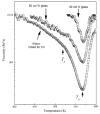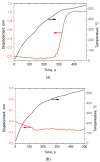Metallic Glass-Reinforced Metal Matrix Composites: Design, Interfaces and Properties
- PMID: 36499775
- PMCID: PMC9739044
- DOI: 10.3390/ma15238278
Metallic Glass-Reinforced Metal Matrix Composites: Design, Interfaces and Properties
Abstract
When metals are modified by second-phase particles or fibers, metal matrix composites (MMCs) are formed. In general, for a given metallic matrix, reinforcements differing in their chemical nature and particle size/morphology can be suitable while providing different levels of strengthening. This article focuses on MMCs reinforced with metallic glasses and amorphous alloys, which are considered as alternatives to ceramic reinforcements. Early works on metallic glass (amorphous alloy)-reinforced MMCs were conducted in 1982-2005. In the following years, a large number of composites have been obtained and tested. Metallic glass (amorphous alloy)-reinforced MMCs have been obtained with matrices of Al and its alloys, Mg and its alloys, Ti alloys, W, Cu and its alloys, Ni, and Fe. Research has been extended to new compositions, new design approaches and fabrication methods, the chemical interaction of the metallic glass with the metal matrix, the influence of the reaction products on the properties of the composites, strengthening mechanisms, and the functional properties of the composites. These aspects are covered in the present review. Problems to be tackled in future research on metallic glass (amorphous alloy)-reinforced MMCs are also identified.
Keywords: amorphous alloy; electrical conductivity; interface; mechanical properties; metal matrix composites; metallic glass; microstructure; reinforcement.
Conflict of interest statement
The authors declare no conflict of interest. The funders had no role in the design of the study; in the collection, analyses, or interpretation of data; in the writing of the manuscript, or in the decision to publish the results.
Figures




















References
-
- Lloyd D.J. Particle reinforced aluminium and magnesium matrix composites. Int. Mater. Rev. 1994;39:1–23. doi: 10.1179/imr.1994.39.1.1. - DOI
-
- Tjong S.C. Novel nanoparticle-reinforced metal matrix composites with enhanced mechanical properties. Adv. Eng. Mater. 2007;9:639–652. doi: 10.1002/adem.200700106. - DOI
-
- Mortensen A., Llorca J. Metal matrix composites. Annu. Rev. Mater. Res. 2010;40:243–270. doi: 10.1146/annurev-matsci-070909-104511. - DOI
-
- Sweet G.A., Brochu M., Hexemer R.L., Jr., Donaldson I.W., Bishop D.P. Consolidation of aluminum-based metal matrix composites via spark plasma sintering. Mater. Sci. Eng. A. 2015;648:123–133. doi: 10.1016/j.msea.2015.09.027. - DOI
-
- Alaneme K.K., Okotete E.A., Fajemisin A.V., Bodunrin M.O. Applicability of metallic reinforcements for mechanical performance enhancement in metal matrix composites: A review. Arab J. Basic Appl. Sci. 2019;26:311–330. doi: 10.1080/25765299.2019.1628689. - DOI
Publication types
Grants and funding
LinkOut - more resources
Full Text Sources

